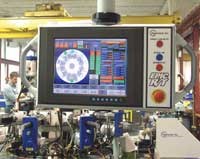Closing The CNC Price Gap
Applying CNC technology to the manufacturing of precision parts is generally accepted as a premium that one must pay for the advantages over conventional actuation systems. Increasingly, however, the gap is narrowing as economies of scale for producing CNC equipped machine tools are incorporated in the unit price of a given machine. In other words, spreading the costs of manufacturing over a larger base of installations will reduce the price of each machine.
Applying CNC technology to the manufacturing of precision parts is generally accepted as a premium that one must pay for the advantages over conventional actuation systems. Increasingly, however, the gap is narrowing as economies of scale for producing CNC equipped machine tools are incorporated in the unit price of a given machine. In other words, spreading the costs of manufacturing over a larger base of installations will reduce the price of each machine.
So making bigger production batches is one way to get the cost of individual machine tools down. Another way to achieve this goal is through innovation. Hydromat (St. Louis, Missouri) recently unveiled its new EPIC R/T rotary transfer machine series that exemplifies the latter form of cost reduction.
The Hydromat rotary transfer machine design has been a success in manufacturing of high volume, precision parts. Key to this design has been the machine’s modularity. Its machining modules are interchangeable and reconfigurable for a huge variety of machining operations.
But as good as any given design is, there is usually room for improvement. In Hydromat’s case, the company was researching a way to improve its CNC rotary transfer machines. Like so much of the precision parts manufacturing industry, the driver comes from the need for more frequent machine setups and tear downs as job lots get smaller and JIT inventory programs change the dynamics of what high volume production means. The goal for the team developing the new EPIC R/T line was to create a CNC machine that is comparable in price to current non-CNC Hydromat machines. By reducing the premium between a CNC and conventional Hydromat machine, the risk of applying the CNC technology also goes down for the shop owner. The idea is that the technological choice between CNC and non-CNC should be driven by the application rather than price.
The key technological innovation developed by the company’s St. Louis based team of electrical engineers is called EMC. It stands for embedded motion control. In keeping with the company’s tradition of modular tool units, the EMC consists of newly designed plug and play control architecture on each of the machine’s tool spindle units.
For each axis of motion, a control system is integrated or embedded in the tool spindle unit and allows fully independent and programmable functionality. Programming of the unit can be done off-line and downloaded from a remote location, or the units can be programmed at the machine. A closed-loop feedback system signals the tool spindle position.
An inherent advantage of EMC is that each tool spindle unit carries its own motion control information in the form of programmed instructions embedded in the EMC. When a tool spindle is moved from one location on the machine to another, the only change needed is to program the unit’s strokes. There is no need to reconfigure the machine’s CNC when tool units are changed out.
Connections of these tool spindle units have been simplified on the new machine. Changing a tool spindle unit on the EPIC R/T machine involves only four connections. One connection is the power for the unit, one is a communication link to the CNC and the other two are the unit’s hydraulic lines.
The basic communication between the CNC and the EMC unit is via a stop and start signal. The start signal in the tool spindle tells the CNC that its programmed motion has begun. When the program is complete, another signal to the control tells it that the cycle is complete. When all of the tool spindle units complete their programmed moves, the rotary transfer table indexes. It’s a simple synchronization system.
To accommodate the newly configured tool spindle units, the base of the EPIC R/T machine has been redesigned because the new line eliminates some of components that are used on Hydromat non-CNC machines. Among the benefits of this redesign is a less expensive machine base that helps make the new CNC machine virtually cost neutral compared to the non-CNC machine.
The first machine to be equipped with the new EMC technology is a 12-station rotary transfer model. Plans call for building a complete line of these machines in the near future.
Related Content
CNC Rotary Transfer Machine Offers AI-Learning, Chipbreaking
Hydromat’s Force CNC Rotary Transfer Machine comes equipped with Force 50/150 tool spindle units, which are FANUC-controlled and offer advanced technology for AI-learning and chipbreaking functions.
Read MorePrecision Machining Technology Review: August 2024
Production Machining’s August 2024 technology showcase includes some of the latest technology from SW North America, Tsugami, Siemens, Select Manufacturing Technologies, Hurco and ECI Software Solutions — all on display at IMTS 2024.
Read MoreEdge Technologies Bar Feeding Solutions Support Range of Production Environments
IMTS 2024: Edge Technologies' product showcase includes a magazine feeder and short loader, as well as a bar feeder, pusher and separation system.
Read MoreEdge Technologies Bar Feeder Maximizes RPM Potential
The second-generation Patriot 338 and 551 were designed for faster changeovers, ease of use and safe operation.
Read MoreRead Next
5 Aspects of PMTS I Appreciate
The three-day edition of the 2025 Precision Machining Technology Show kicks off at the start of April. I’ll be there, and here are some reasons why.
Read MoreA Tooling Workshop Worth a Visit
Marubeni Citizen-Cincom’s tooling and accessory workshop offers a chance to learn more about ancillary devices that can boost machining efficiency and capability.
Read MoreDo You Have Single Points of Failure?
Plans need to be in place before a catastrophic event occurs.
Read More












.jpg;maxWidth=300;quality=90)












